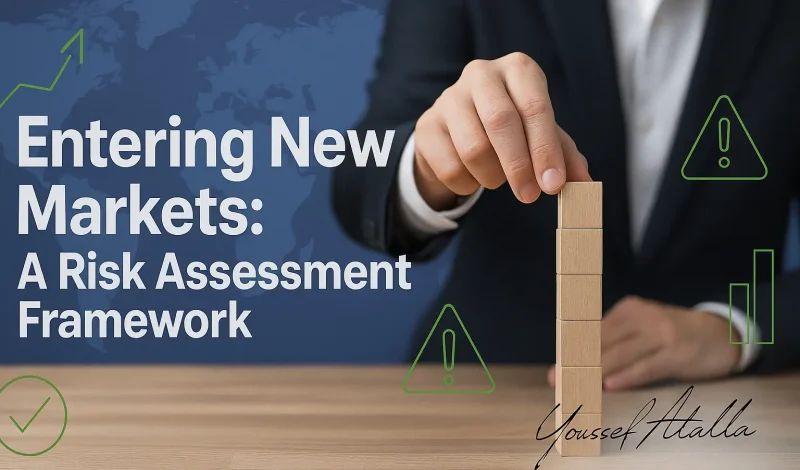Expanding into new markets can be a game-changer for any organization aiming to scale. But with opportunity comes risk. From political shifts to cultural mismatches, companies must evaluate numerous factors before committing to a global expansion strategy. This guide for entering new markets outlines a practical risk assessment framework to help businesses plan their market entry strategy effectively and sustainably. It’s particularly valuable for companies looking to grow through business scaling, and for those consulting with a trusted business consultant on international growth.
Understanding Your Market Entry Strategy
Choosing how to entering new markets sets the foundation for your success. The process involves more than picking a country, it’s about aligning your capabilities with the market’s conditions, regulations, and demands. Your strategy must support your long-term goals and ensure minimal disruption during execution.
What Is a Market Entry Strategy?
A market entry strategy is a detailed plan that outlines how a company will deliver goods or services to a new target market. It includes factors like pricing, distribution channels, legal compliance, and marketing approaches. A sound strategy also assesses your competitive positioning and the customer experience you aim to deliver. The right approach helps minimize risk and improve the likelihood of long-term success.
Conducting Thorough Market Risk Assessments
Jumping into a new region without a clear view of the risks is a recipe for trouble. A comprehensive risk assessment framework ensures you identify both visible and hidden challenges. This critical step informs all other aspects of entering new markets.
Evaluating Political & Regulatory Risks
One of the first steps in market risk analysis is understanding the political landscape. Sudden regulatory changes, political instability, or import restrictions can significantly affect operations. For example, different labor laws, tax structures, and legal systems could impact your financial planning and HR services setup in the new region.
Assessing Currency, Trade & Tariff Exposure
Currency fluctuations and unexpected tariffs can erode profit margins. Assess the financial risks tied to exchange rates, customs duties, and trade agreements. Tools such as hedging or long-term pricing contracts can help mitigate exposure. Strong financial management practices are key to navigating this phase confidently.
Choosing the Right Mode of Entry
There are several ways to enter a new market, each with its benefits and drawbacks. Options include direct exporting, licensing, joint ventures, acquisitions, and greenfield investments. The right choice depends on your business goals, risk tolerance, and available resources.
- Direct Exporting: Fast and lower cost, but limited control.
- Licensing & Franchising: Leverages local partners, but could dilute brand control.
- Joint Ventures: Useful in high-barrier markets, but require trust and alignment.
- Acquisition: Immediate market access, yet expensive and integration-intensive.
- Greenfield Investment: Full control, ideal for long-term growth, but very resource-intensive.
Understanding these options helps you tailor the strategy that best supports your business development and long-term global expansion goals.
Financial Planning & Budgeting for Expansion
Before expanding, businesses must get their financial house in order. Clear budgeting and financial planning can make or break your success in a new region. Many expansion attempts fail due to underestimated costs or overestimated returns.
Forecasting Cost, Revenue, & ROI
Accurately forecasting expenses and returns is essential. Include fixed and variable costs, from marketing to operations, legal fees, logistics, and localization. Use historical data and benchmarking from similar markets to develop realistic ROI projections. Align these projections with your strategic growth plan.
Financing Growth: Loans, Investors, & Partnerships
Securing capital through loans, investors, or strategic partnerships is often necessary for large-scale expansions. Consider government grants, development funds, and local investment incentives. Align funding strategies with your expansion model to ensure stability and flexibility.
Developing a Risk-Informed Go-to-Market Plan
Once your strategy and budget are in place, the next step is planning the execution. A well-structured go-to-market plan reduces uncertainty and ensures a smoother rollout. This includes outlining marketing campaigns, sales strategies, and customer support plans.
Timeline, Milestones & KPIs
Break down your launch into phases with specific milestones. Use KPIs to track progress and make adjustments as needed. Be realistic about timelines, global expansion often takes longer than anticipated. Establish weekly or monthly review points to assess what’s working and where improvements are needed.
Contingency & Exit Strategies
Every solid plan includes a backup. Whether it’s reallocating resources, pausing the rollout, or exiting the market altogether, prepare for what you’ll do if your initial efforts don’t meet expectations. Flexibility is crucial when entering unfamiliar environments.
Building Local Partnerships & Ecosystem Support
Local partners can provide the cultural knowledge, legal compliance, and market access you need. Identify reliable distributors, agents, and service providers who align with your brand’s values and operational standards. These relationships can also enhance your customer experience by ensuring faster and more relevant service. Strong ecosystems help companies adapt more quickly and avoid common pitfalls.
When selecting partners, consider not only operational alignment but also shared long-term vision. Good partnerships go beyond transactional relationships; they become vital extensions of your brand and growth engine.
Scaling Globally: From Pilot to Full Launch
Start small to validate your assumptions. A pilot program allows you to test operations, marketing, and logistics before scaling up. Monitor performance, collect feedback, and make data-driven improvements. This agile approach minimizes risk and increases your chances of success across broader regions.
As you move from pilot to full-scale launch, retain adaptability. Continue learning from early results and adjusting your strategy. Businesses that view global expansion as a phased, iterative process typically outperform those that rush to market without adequate testing.
Expanding internationally is an exciting but complex journey. By applying a structured risk assessment framework and considering every facet, from regulations and finance to partnerships and execution, businesses can navigate challenges with confidence. Whether your organization specializes in HR services, seeks improved customer experience, or focuses on growth through strategic business development, market entry planning must be intentional and informed.
In today’s competitive environment, a thoughtful, risk-informed strategy is what separates successful global ventures from costly failures. Use this guide for entering new markets as a foundation to chart your path toward meaningful, sustainable global expansion with contact now Youssef Attalla business consultant.





